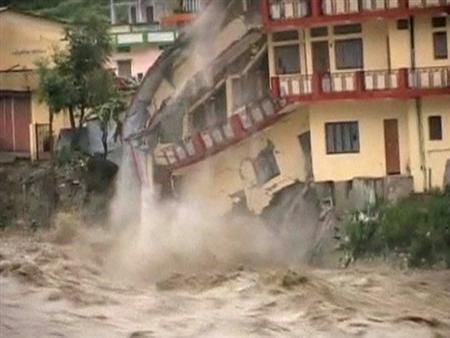Monsoon Floods In North India: Thousands Feared Dead, Military Assists In Rescue Ops [PHOTOS]
India's military stepped up rescue operations in the state of Uttarakhand where more than 150 people are dead according to official estimates, while thousands more are missing after flash floods and landslides caused by heavy rains wreaked havoc in the region, which lies in the foothills of the Himalayas.
Thousands are feared dead in the state as rescue operations struggled to reach several villages in the state's rugged, mountainous terrain, which remains inundated from the downpour and cut off by landslides from the rest of the state.
The Army and Air Force resumed operations by Thursday morning in flood-hit areas after bad weather hampered rescue efforts Wednesday late night as helicopters could not reach affected areas from the state capital, Dehradun.
"Since 6.30 in the morning three choppers have been on job. So far, 77 tourists were airlifted," an official told Indo-Asia News Service.
The hill resorts of Uttarakhand are a major attraction for local and foreign tourists while the upper reaches of the state -- home to Hindu temples -- attract millions of pilgrims each year. Certain media reports estimate that it will take more than two years of redevelopment for the region to return to normalcy.
The maximum destruction is reported to have occurred in the temple town of Kedarnath where thousands of tourists and locals are feared trapped. According to the State Disaster Mitigation and Management Centre, casualties may number in the thousands as about 90 rest houses for pilgrims were swept away by flood waters.
However, the current official estimate of the death toll stands at 150.
So far, more than 15,000 people stranded in Kedarnath and Govindghat, another pilgrimage center, have been rescued and shifted to relief camps, a senior police official told Press Trust of India.
Several villages in Chamoli and Rudraprayag districts remained flooded making it impossible for rescue personnel to assess the damages and casualties. According to local media reports, flooding in the Alaknanda River in Rudraprayag, known for its white-water, washed away whole villages and bridges, causing heavy damages.
Environmentalists have blamed unplanned development activities in the region for its current predicament, arguing that destruction of forest cover, closely-spaced hydro-power projects on the state's rivers, and unbridled commercial construction have destabilized the ecological balance.
In the country's capital, New Delhi, which lies about 350 kilometers (217 miles) to the southwest, rising water levels in the Yamuna river flowed over its banks to flood houses and buildings, forcing hundreds of people to evacuate. The flood waters also disrupted rail and road transport services in the region, media reports said.
The monsoon season in India, which lasts about four months from June to September, brings rains all across the country, and is vital for its farming sector and economy.














© Copyright IBTimes 2025. All rights reserved.






















